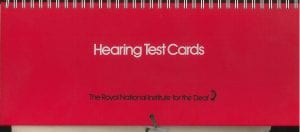Michael Reed OBE, teacher, psychologist, & RNID Chairman 1975-85
By H Dominic W Stiles, on 23 November 2018
 Michael Reed, (1913-99) was a psychologist, audiologist, and teacher of the deaf, and was the first educational psychologist in England to work with deaf children. He was employed at the Royal National Throat Nose and Ear Hospital, Gray’s Inn Road, London, from 1949-1961. He then moved to the Inner London Education Authority as Her Majesty’s Inspector for Special Education, with responsibility for deaf pupils. He remained there until his retirement in 1978, and then settled in Canada in 1989.
Michael Reed, (1913-99) was a psychologist, audiologist, and teacher of the deaf, and was the first educational psychologist in England to work with deaf children. He was employed at the Royal National Throat Nose and Ear Hospital, Gray’s Inn Road, London, from 1949-1961. He then moved to the Inner London Education Authority as Her Majesty’s Inspector for Special Education, with responsibility for deaf pupils. He remained there until his retirement in 1978, and then settled in Canada in 1989.
Michael Reed was the author of the Reed Picture Screening Test (see below) and Educating hearing impaired children, published by the Open University Press in 1984.
He had a long involvement with the NID/RNID. He was co-opted onto the NID Medical and Scientific Committee in 1956, then elected onto the Council of Management in 1957. He became Vice-Chairman of the RNID in 1972, and Chair from 1975-85.
In 1986 he was awarded the OBE and created a Vice-President of the RNID for life.
Here we see him in 1984, in the centre, flanked by Tom and Brenda Sutcliffe, from the then RNID magazine, Soundbarrier. 
AKHURST, B.A. Michael Reed OBE 1913-1999. Psychologist, 2000, Jul, 2000, p.338.
REED PICTURE SCREENING TEST FOR HEARING This was a set of pictures of everyday objects for screening primary school children’s hearing, devised by Michael Reed and published by the RNID in 1960.
This was a set of pictures of everyday objects for screening primary school children’s hearing, devised by Michael Reed and published by the RNID in 1960.
He uses the language of the time – ‘defect’ sounds uncomfortable to us now, and probably did in the 1960s to some.
PICTURE SCREENING TEST OF HEARING By Michael Reed, B.SC.
THERE IS NO DOUBT that the earlier a hearing defect is discovered the more the handicap caused by such a defect can be alleviated. The picture presented by severe or total deafness is all too obvious, but in the case of slight or moderate deafness, the picture is sometimes more obscure. Many children have been thought to be mentally very dull when, in fact, they have been partially or severely deaf. Frequently they had become frustrated and non-co-operative and therefore it had become difficult to establish the true facts. Many simple cases of deafness have been misdiagnosed because a complete understanding of the effects of distorted hearing or slight hearing losses has been lacking. Children with slight hearing losses which are not obvious may become educationally retarded in the adverse noise conditions of a class-room. Therefore it is extremely important to discover any significant hearing loss as soon as possible in order to be aware of the problem and so help the child. If there is a slight loss of hearing for all frequencies throughout the speech range, or severe loss for frequencies above 1000Hz, there will be some disability in discriminating between consonants. The R.N.I.D. Picture Screening Test has been designed around this simple fact. It is interesting to children and therefore fairly certain of ensuring their co-operation, and is easy both to carry around and to use.
The test is made up of several separate cards each of which has four pictures. The names of the pictures conform with the following conditions.1. The words must be monosyllabic so that the rhythm of that word does not give a clue.
2. The words in any one row must contain the same vowel sound.
3. The words must be those within the vocabulary of the children to be tested.
The test as designed here can be used for children with a mental age of four years and older and with many children of mental age of three years. To ensure that the child to be tested knows the name of the picture, he is told how to name the pictures first, especially with very young children. If the child calls the owl a bird, one says ‘That’s right but I am going to call it an owl.’ Similarly if the hen is called a chicken, or the sheep a lamb, or the lamb a sheep, he is told that it is to be called a hen a sheep and a lamb so that the words do have the common vowel sound. If the child does not know any words then one cannot test in this way and if in doubt, a full audiometric examination must be requested.
REED, M. A verbal screening test for hearing. proceedings of the 3rd World Congress of the Deaf, Weisbaden, 1959. Deutschen-Gerhorlosen-Bundes, 1961. pp. 195-97.
HOLDING, B., HOLDING, J. and OWEN, A. Prawf clyw darluniadol Dyfed. British Journal of Audiology, 1987, 21. 147. (Welsh version)
McCORMICK, B. Screening young children for hearing impairment. Whurr, 1994. pp. 76-77.
 Close
Close

